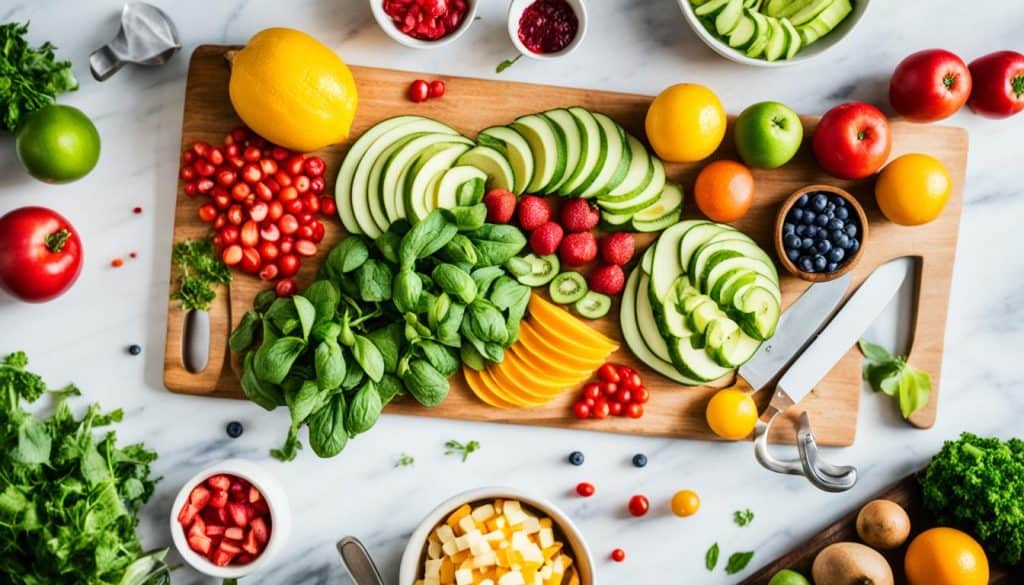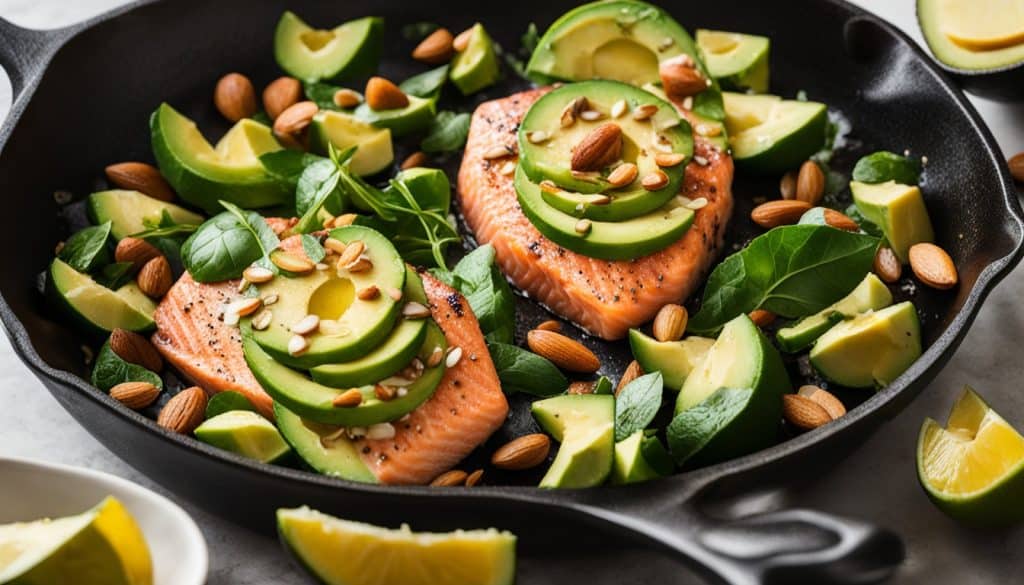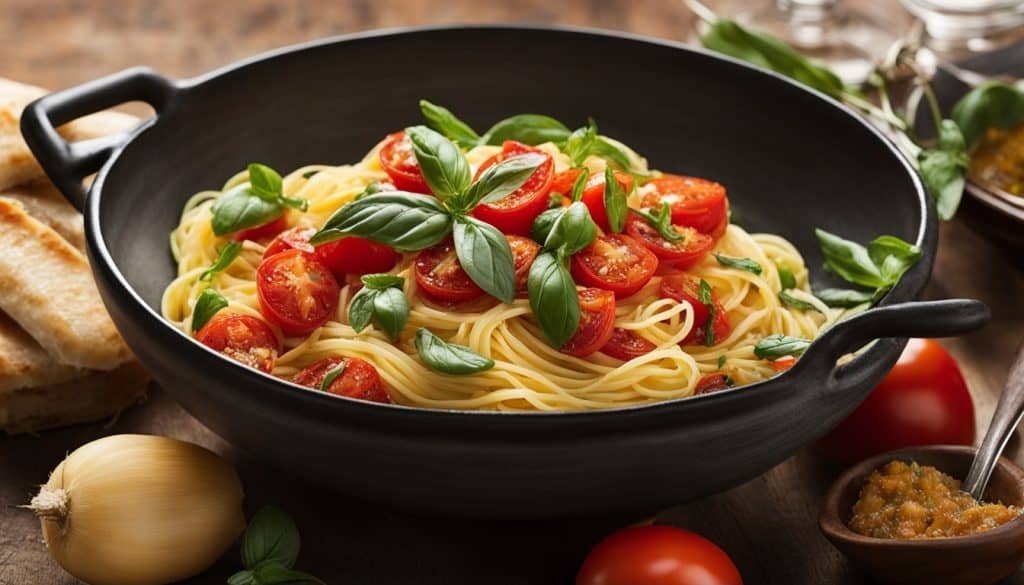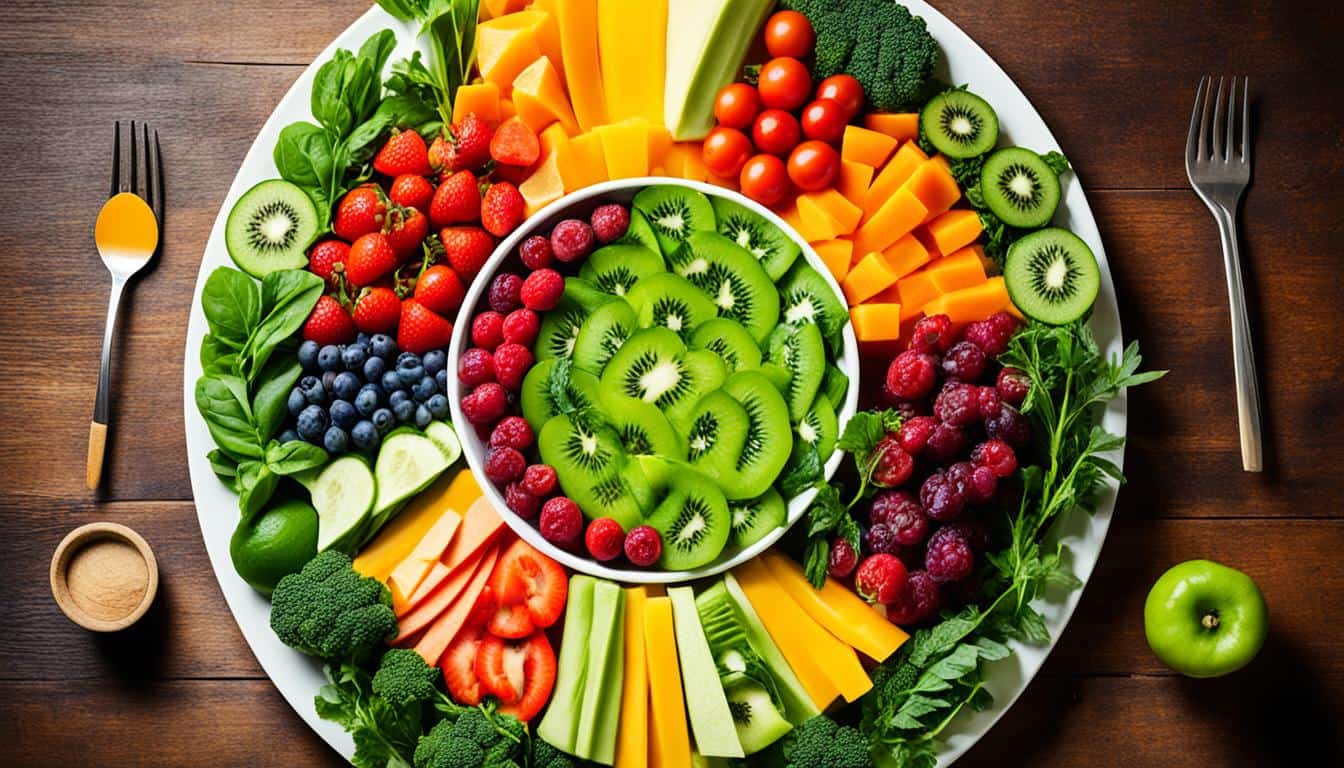Cooking for health means making meals that taste great and are good for you. By using these tips, you can make food that feeds your body and pleases your taste buds.
Let me share a story about my friend Sarah. Sarah was always busy, juggling work, family, and friends. She often chose quick, easy meals that weren’t very healthy. But after learning about how many adults don’t eat enough fruits and veggies, she decided to change.
Sarah started trying new cooking methods and using healthier ingredients. She found that small changes to her favorite recipes could make a big difference. For example, she swapped lasagna noodles for zucchini in her Zucchini Lasagna Roll-Ups, cutting carbs and adding veggies.
She also learned about the importance of protein and healthy fats in meals. By changing the shrimp to avocado ratio in her Summer Roll Bowls, she made a more filling and healthy dish.
Comparing foods, Sarah found that cabbage wraps have more fiber and nutrients than lettuce wraps. So, she made Cheeseburger Cabbage Wraps, enjoying a tasty meal and eating more veggies.
To eat fewer carbs, Sarah used cauliflower instead of rice in her Cauliflower Fried Rice. This made the dish lighter and more nutritious, and helped her eat more veggies.
As Sarah kept exploring healthy cooking, she found ways to eat more protein. Adding cottage cheese to her Alfredo sauce made it creamier and more protein-rich, boosting the dish’s nutrition.
Key Takeaways:
- Swapping ingredients like zucchini for lasagna noodles and cauliflower for rice boosts your meal’s nutrition.
- Adjusting the protein and healthy fats in your recipes makes for a better balance.
- Looking at nutritional values helps you pick the best ingredients.
- Adding cottage cheese to sauces is a creative way to increase protein in your meals.
- Trying new cooking methods and ingredients can lead to exciting flavors and textures.
The Benefits of Cooking at Home
Cooking at home is great for your health and well-being. You get to choose what goes into your meals. This lets you focus on eating nutritious whole foods. This can greatly improve your health and energy levels.
Studies by Forbes show that cooking at home is healthier and cheaper than eating out. In fact, eating out can be five times pricier than cooking at home. By cooking yourself, you save money and eat healthier.
Blue Apron is a meal delivery service that values cooking healthy meals at home. They offer over 50 meal options weekly, using ingredients like veggies, whole grains, and lean proteins. Their Wellness meals are made to boost your health and come in 2 or 4 servings with options for your diet.
Blue Apron knows cooking is convenient, so they offer Heat & Eat Meals that just need to be warmed up. They also have a Meal Prep Bundle for the week, saving you time and effort.
Cooking at home is good for your health and wallet. It can help prevent illnesses like heart disease, cancer, high blood pressure, and diabetes. Studies from places like the University of Washington and Johns Hopkins University show that home cooks tend to eat healthier without spending more on food.
Cooking at home is also good for your mind. It can reduce stress, boost creativity, and make you feel positive. Plus, it’s a chance to learn about nutrition and bond with family over meals.
Even though 90% of Americans don’t like cooking, it’s worth trying. You can make tasty, healthy meals and take charge of your health. It’s a simple way to make positive changes for you and your family.
So, why not start cooking at home? It’s easy and rewarding, offering many benefits for your life. Try adding more whole foods to your meals and find new recipes to enjoy. Your health and happiness will improve.

Choosing Whole Foods
Choosing whole foods is a great way to cook for health. Whole foods are ingredients that haven’t been heavily processed. They give you lots of nutrition and taste. Unlike processed foods, which have long lists of ingredients, whole foods have just one item on their list. This makes it easier for you to know what you’re eating.
Studies show that eating a lot of whole foods is good for you. Foods like fruits, veggies, whole grains, lean proteins, and healthy fats can lower your risk of many diseases. This proves how important it is to eat whole foods.
It doesn’t matter if you pick organic or regular whole foods. They both offer great nutrition. Eating more fruits and veggies is good for you, no matter their origin. By using whole foods in your meals, you make sure you get the vitamins, minerals, and fiber your body needs.
Processed foods can be bad for your heart. They often don’t have the nutrients you need and can have too much sugar and salt. Choosing whole foods over processed ones helps you avoid these risks. This way, you feed your body with foods that are good for you.
When you cook with whole foods, you can make your meals just how you like them. You control the ingredients and can change recipes easily. Adding more whole foods to your meals also means you eat more veggies. This is key for a healthy diet.
A whole foods diet isn’t a strict plan from a book or expert. It’s a way of eating that focuses on real, healthy foods. It means picking foods that are as close to their natural state as possible. It also means eating fewer processed and packaged foods that often have less nutrition.
In short, eating whole foods is good for your health. By choosing foods that are minimally processed, you feed your body well. You avoid the risks of processed foods. Eating whole foods like fruits, veggies, whole grains, and lean proteins helps you take charge of your diet. It supports your health and well-being.
Using Better Fats
Choosing the right fats can greatly improve our health and the taste of our food. Not all fats are the same, and picking the best ones can make a big difference. Let’s look at some great fats to add to our cooking.
The Importance of Healthy Fats
Fats are key in our diet, giving us energy and helping with cell growth and nutrient absorption. It’s important to know the difference between healthy and unhealthy fats. Healthy fats like monounsaturated and polyunsaturated fats are better for us than saturated and trans fats.
The Benefits of Monounsaturated Fats
Monounsaturated fats are great for cooking and are found in olive oil, avocados, and nuts. They’re good for the heart and are known for their health benefits. Extra virgin olive oil is a top choice for healthy fats.
Studies show that these fats can lower bad cholesterol, cut heart disease risk, and help control blood sugar. Adding them to our cooking makes our meals healthier and tastier.
Exploring Other Healthy Options
There are other healthy fats we can use besides olive oil. Avocado oil is great for high-heat cooking because of its high smoke point and mild taste. Coconut oil is also popular, especially for baking and spreading on toast, adding a unique flavor to our treats.
Optimizing Fats for Specific Uses
For a healthier butter substitute, mix extra virgin olive oil and virgin coconut oil in equal parts. This blend makes a tasty spread for bread, crackers, or in recipes.
For salad dressings, use extra virgin olive oil or cold-pressed seed oils for their light flavor. Cold-pressed flaxseed oil is also good because it’s full of omega-3 fatty acids, which are good for the heart and joints.

The Verdict on Vegetable Oils
While vegetable oils are common, they might not be the best choice. Many have linoleic acid that can turn into harmful fats when heated. These fats can be bad for our health. So, it’s better to use healthier fats instead.
By picking fats like olive oil, avocado oil, and coconut oil, we make our meals healthier and tastier. Let’s choose wisely when it comes to fats to improve our cooking and health.
Don’t Skimp on Flavor
When cooking for health, don’t forget about flavor. Many think that too much sodium is bad for the heart, but there’s little proof of this. Salt helps replace lost electrolytes and makes food taste great. And spices can really elevate your meals.
Spices like ground pepper, paprika, garlic powder, and onion powder can transform your dishes. They boost flavor and have health perks too. Garlic powder boosts the immune system, and paprika is full of antioxidants. So, don’t hesitate to spice up your food!
Healthy Italian recipes let you enjoy tasty meals without feeling guilty. Each dish is packed with protein and has less than 400 calories per serving. This makes them both healthy and delicious.
Imagine enjoying a slice of healthy spaghetti pie with just 256 calories. Or a 2-cup serving of penne dish with only 301 calories. These recipes show you can eat well without giving up flavor.

Reducing Calorie Intake with Flavorful Lasagna
Lasagna is a classic Italian dish loved by many. The recipes here are low in calories but full of flavor. They use fresh and frozen veggies to save time and boost nutrition.
This approach lets you eat a filling meal with fewer calories. Adding lots of veggies makes the lasagna taste and feel great. It’s a meal that’s both tasty and healthy.
So, don’t be afraid to add flavor to your healthy meals. Use salt and spices to make your Italian dishes pop. You can eat well and enjoy every bite!
Creating an Organized Kitchen
Having an organized kitchen is crucial for cooking healthy meals. A tidy space saves time and makes cooking more enjoyable. Here are some tips to make your kitchen functional and efficient:
Declutter and Evaluate
Begin by clearing out your kitchen and checking what you have. Get rid of anything you haven’t used in a year. This frees up space. Regularly go through your pantry to get rid of expired or unused items. This keeps your kitchen clean and ready for cooking.
Strategize Placement
Think about where you put things in your kitchen for efficiency. Keep important items at eye level for easy reach. Have a foldable step stool for reaching high shelves. Also, make areas easy for kids to get to, encouraging them to help with meals.
Create Zones
Organize your kitchen into zones to make cooking smoother. Set up separate areas for prep, cooking, dishes, and storage. Keep prep and cooking zones close for quick meal prep. Use big cutting boards and bowls to make prep easier. Keep onions and garlic close to the prep area for convenience.
Efficient Storage Methods
Use smart storage to make the most of your space. Keep utensils near the stove for quick access. Store oils in a cool, dark spot near the stove to keep them fresh. Seasonings like salt and pepper should be easy to reach. Make sure your favorite pots and pans are within reach for easy cooking. Use glass jars for storing food and keep pantry items visible and easy to get to.
Seek Professional Help
If organizing your kitchen feels too hard, get help from a professional organizer. Gayle Gruenberg, a top organizer, suggests a four-step process: Gather, Sort, Contain, and Maintain. With her help, you can organize your kitchen well and keep it that way.
Working with Gayle and her team takes about an hour, but it’s worth it. Contact Gayle at Gayle@lgorganized.com or visit her website at lgorganized.com. Follow her advice to turn your kitchen into a neat and useful space. Post your organized pantry photos on Instagram in the NS Community with #NSHealthyShelfie.
Cooking Methods and Tools
Choosing the right cooking methods and tools is key to cooking healthy and tasty meals. Different cooking methods can boost your ingredients’ flavors and keep their nutrients.
Stir-frying is a popular method that cooks food quickly at high heat. This helps keep the texture, flavor, and nutrients of the ingredients. Stir-frying can even keep antioxidants in veggies like broccoli and kale, which are good for fighting inflammation. Use a flat-bottom wok, like an affordable carbon-steel one with a wooden handle, for stir-frying. This wok gets a natural non-stick surface, so you need less oil for cooking.
Prepping your ingredients before cooking is important for a great stir-fry. Use quick-cooking proteins like chicken breast, shrimp, or tofu. Good veggies for stir-fries include bell peppers, mushrooms, and zucchini. But, hard veggies like beets and potatoes might not cook right. Make sure your wok or skillet is hot before adding oil for the best results. Don’t overcrowd the pan and stir the veggies often to avoid steaming.
High-quality kitchen tools are a must for easy meal prep. Stainless steel cookware is great because it’s durable, doesn’t react with food, and heats evenly. Having two sizes of stainless steel pans gives you more cooking options. A set of pots and pans, including a saucepan, soup pot, and skillet, meets various cooking needs. For baking and roasting, use different ovenware like stainless steel, ceramic, stoneware, and glass.
Having the right tools is also important, like a chef’s knife, paring knife, serrated knife, and vegetable peeler for prep work. Useful tools also include a pressure cooker for quick meals, a mandolin for precise slicing, a salad spinner for crisp salads, and blenders like Vitamix and Nutribullet for smoothies and sauces. A food processor can also help with chopping and blending ingredients.
Choosing the right cooking methods and tools can make cooking easier and improve your meals. So, whether you’re stir-frying, roasting, baking, or using another method, pick the right tools and enjoy making your meals.


